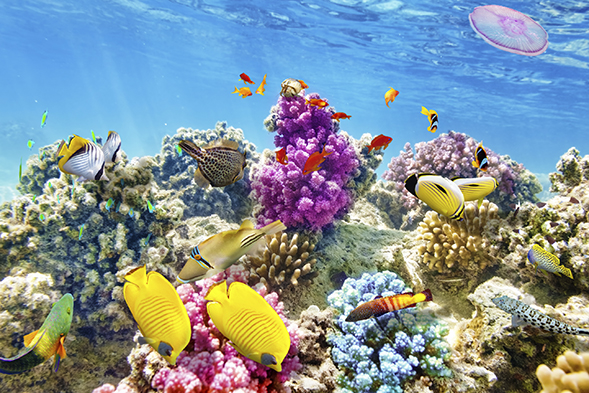Measuring Beauty
SDSU scientists created a new computer program capable of measuring the beauty of coral reefs.

Since antiquity, philosophers and art historians around the world have searched for universally valid criteria for aesthetic principles — in other words, a way to quantitatively describe things like beauty and ugliness. The development of a powerful new computational approach will now allow for a more comprehensive assessment of what people find aesthetically pleasing.
Almost every person has an appreciation for natural environments. In addition, most people find healthy or pristine locations with high biodiversity more beautiful and aesthetically pleasing than environmentally degraded locations.
In a study which computed ‘aesthetics’ as it relates to coral reefs, a multidisciplinary group of researchers have shown that an objective computational analysis of photographic images can be used to assess the health of a coral reef.
Calculating aesthetic appeal
Working together, mathematics, biology, and art history researchers from San Diego State University, the Getty Research Institute, and the Scripps Institution of Oceanography created a tool to computationally measure the aesthetic appearance of coral reefs. The results demonstrate that objective visual cues generated from random photographic images can be used to reliably assess both the beauty and health of coral reefs around the world.
The collaborators compiled and modified a list of 109 visual features that can be used to assess the aesthetic appeal of an image, such as the relative size, color, and distribution of discernable objects within the image, as well as texture and color intensity. They then created a computer program capable of assessing these features in images and used it to analyze more than 2,000 random photographic images of coral reefs from around the world. The program produced an aesthetic score for each reef ecosystem.
The study, “Can we measure beauty? Computational evaluation of coral reef aesthetics,” was published Nov. 10 in the scientific open access journal PeerJ. The findings show striking similarities between the aesthetic score produced for random reef images and the health of the respective reef ecosystem as evaluated by reef scientists.
“Our results suggest that our perception of aesthetics is well-aligned with healthy, thriving ecosystems,” said Andreas Haas, an SDSU postdoctoral scholar and primary researcher of the study.
How beauty translates health
The results of this unique and multidisciplinary endeavor demonstrate that human perception of aesthetic value is not purely subjective, but is influenced by inherent components of nature that indicate healthy or degraded states. Ecologists may be able to use this tool or ones like it as a quick and inexpensive approach to monitoring the status and health trajectories of coral reef communities.
“By quantifying aesthetic features of coral reef systems, this method provides a cost effective tool that also targets one of the most important socioeconomic values of coral reefs — their natural beauty,” Haas said.
A new website created by the researchers allows users to upload an image and get an aesthetic score back using the techniques developed in this study.



